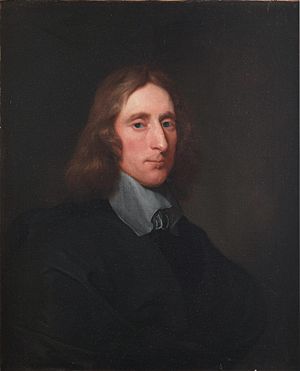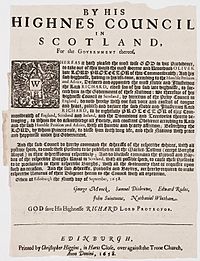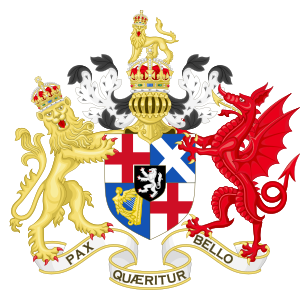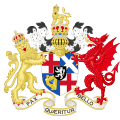Richard Cromwell facts for kids
Quick facts for kids
Richard Cromwell
|
|
|---|---|

Portrait by Gerard Soest
|
|
| Lord Protector of the Commonwealth of England, Scotland and Ireland | |
| In office 3 September 1658 – 25 May 1659 |
|
| Preceded by | Oliver Cromwell |
| Succeeded by | Council of State |
| Personal details | |
| Born | 4 October 1626 Huntingdon, Huntingdonshire, England |
| Died | 12 July 1712 (aged 85) Cheshunt, Hertfordshire, England |
| Spouse | |
| Children |
See list
Edward Cromwell
(1644–1688) Elizabeth Cromwell (1650–1731) Anne Cromwell (1651–1652) Mary Cromwell (1654) Oliver Cromwell (1656–1705) Dorothy Cromwell (1657–1658) Anna Cromwell Gibson (1659–1727) Dorothy Cromwell Mortimer (1660–1681) |
| Parents |
|
| Military service | |
| Branch/service | New Model Army |
| Years of service | 1647 |
Richard Cromwell (born 4 October 1626 – died 12 July 1712) was an English leader. He was the second and last Lord Protector of England, Scotland, and Ireland. His father, Oliver Cromwell, was the first Lord Protector.
Richard became Lord Protector when his father died in 1658. However, he did not have strong control over the country. He tried to bring together the army and the government. He also allowed a Parliament to meet, which included many people who disagreed with him.
The army worried that the government was trying to take away their power. This led to a big disagreement. The army showed its strength against Richard, and he may have been held captive. He officially gave up his power just nine months after becoming leader.
After Richard left power, a Royalist uprising was stopped by General John Lambert. But then General George Monck marched from Scotland, and Lambert's army left him. Monck then helped bring back the King in 1660. Richard Cromwell went to live in Europe and stayed out of public life. He later returned to England and died at 85. For a long time, he was the oldest British head of state, until Elizabeth II lived longer in 2012.
Contents
Richard Cromwell's Early Life and Family
Richard Cromwell was born in Huntingdon on 4 October 1626. He was the third son of Oliver Cromwell and his wife, Elizabeth. We don't know much about his early childhood. He and his three brothers went to Felsted School in Essex. This school was near his mother's family home.
There is no record that he went to a university. In May 1647, he joined Lincoln's Inn, which is a place where lawyers are trained. However, he did not become a lawyer. Instead, in 1647, Cromwell joined the New Model Army. He became a captain in the bodyguard of Viscount Lisle. Later that year, he became a captain in Thomas Fairfax's bodyguard.
In 1649, Richard married Dorothy Maijor. She was the daughter of Richard Maijor, a wealthy gentleman from Hampshire. Richard and Dorothy moved to Maijor's estate in Hursley, Hampshire. They had nine children during the 1650s, but only five lived to be adults.
Richard became a Justice of the Peace for Hampshire. This meant he helped keep law and order in the area. He also served on different local committees. During this time, his father, Oliver, seemed worried about Richard. Oliver wrote to Richard Maijor, saying he wanted Richard to "mind and understand business, read a little history, study the mathematics and cosmography". He thought these things were good for public service.
England's Political Situation
Richard Cromwell's father, Oliver, became a powerful leader during the English Civil War. He started as an unknown Member of Parliament. But he became the commander of the New Model Army, which won the war.
After fighting in Ireland, Oliver Cromwell was unhappy with the government. The Rump Parliament had many debates that didn't lead anywhere. People in Parliament were very suspicious of anything that seemed Catholic. This was because Catholics were linked to the King's side in the war. This led to strict religious rules. Even moderate Anglicans were barely allowed to practice their faith.
A strict Puritan government made people follow the Sabbath very closely. They also banned almost all public celebrations, even at Christmas. Oliver Cromwell tried to change the government. He created an assembly called Barebone's Parliament, made up of people chosen by the army. But their ideas were too extreme, and he had to end this experiment after a few months.
After that, a written constitution created the job of Lord Protector. From 1653 until he died in 1658, Oliver Cromwell ruled with almost all the powers of a king. Richard then took on the role of his father's heir.
Richard's Entry into Politics
In 1653, Richard Cromwell was not chosen to be a member of Barebone's Parliament. However, his younger brother, Henry, was a member. Richard also didn't get any public job when his father became Lord Protector that same year.
But he was later elected to Parliament. He became a Member of Parliament (M.P.) for Huntingdon in the First Protectorate Parliament. He was also M.P. for Cambridge University in the Second Protectorate Parliament.
The Protectorate's rules said that Oliver Cromwell had to name someone to take his place. So, from 1657, Oliver involved Richard more in the government. Richard was there when his father was made Lord Protector for the second time in June. He had not been involved in the first ceremony. In July, Richard was made the leader of Oxford University. In December, he became a member of the English Council of State, which was a powerful government group.
Richard as Lord Protector (1658–1659)

Oliver Cromwell died on 3 September 1658. Richard was told on the same day that he would be the next leader. There is some debate about how Richard became Lord Protector. One letter suggests that Oliver named his son on 30 August. But other ideas say Oliver didn't name anyone, or that he named his son-in-law, Charles Fleetwood.
Richard faced two big problems right away. The first was the army. They questioned his leadership because he had no military experience. The second problem was the government's money. They owed about £2 million.
So, Richard's special council decided to call a Parliament on 29 November 1658. This was to fix the money problems. This Parliament was called using the old rules for elections. This meant the government had less control over who was elected. As a result, when this Third Protectorate Parliament met on 27 January 1659, it had many moderate Presbyterians, secret Royalists, and a few strong Republicans.
The "Other House" of Parliament was also brought back. This group was supposed to balance the Commons. This "Other House" looked a lot like the old House of Lords, which had been removed in 1649. This similarity caused many debates. Republicans argued that bringing back something like the House of Lords was a step towards bringing back the King.
At the same time, the army officers became more and more worried. They felt the government was not supporting the military enough. Richard Cromwell did not have military experience, which bothered the soldiers who had fought in the Civil War. Also, the new Parliament seemed to disrespect the army. Many soldiers found this alarming.
There were fears that Parliament would cut military spending to save money. By April 1659, the army's leaders met. They demanded higher taxes to pay for the government's costs. They sent their complaints to Richard Cromwell on 6 April 1659. He passed them on to Parliament two days later.
But Parliament did not act on the army's ideas. Instead, they put the petition aside. They also increased the army's suspicion by accusing William Boteler of mistreating a Royalist prisoner. This happened while Boteler was a major-general under Oliver Cromwell in 1655.
Then, on 18 April 1659, Parliament passed two rules. These rules said that army officers could not hold meetings without permission from both the Lord Protector and Parliament. Also, all officers had to promise they would not use force against Parliament.
These actions greatly offended the army leaders. This led to a final break between the government and the army. The army demanded that Cromwell dissolve Parliament. When he refused, troops gathered at St. James's Palace. Richard eventually gave in to their demands. On 22 April, Parliament was dissolved. The Rump Parliament was then brought back on 7 May 1659.
In the next month, Richard did not fight back. He refused help from the French ambassador. It's possible the army kept him under house arrest. On 25 May, Richard officially resigned as Lord Protector. This happened after the Rump Parliament agreed to pay his debts and give him a pension. Richard was never officially removed or arrested. He was simply allowed to step aside.
He continued to live in the Palace of Whitehall until July. Then, the Rump Parliament forced him to return to Hursley. Royalists were happy about Cromwell's fall. They made fun of him with nicknames like "Tumbledown Dick" and "Queen Dick".
Richard Cromwell's Later Years (1659–1712)
During the political problems of late 1659, there were rumors that Richard Cromwell might be called back as Protector. But nothing came of these rumors. In July 1660, Cromwell left for France. He never saw his wife again. While in France, he used different fake names, like John Clarke.
He later traveled around Europe, visiting various royal courts. Once, he was invited to dinner with Armand de Bourbon, Prince of Conti. The prince did not know who Richard was. At dinner, the prince asked Cromwell about things happening in England. He said, "Well, that Oliver, though he was a traitor and a villain, was a brave man... but that Richard, that fool and coward, was surely the basest fellow alive; what is become of that fool?" Cromwell replied, "He was betrayed by those he most trusted, and who had been most helped by his father." Cromwell left the town the next morning. During his time in exile, he wrote many letters to his family in England. These letters are now kept in Huntingdon.
Around 1680 or 1681, he returned to England. He lived with a merchant named Thomas Pengelly in Cheshunt, Hertfordshire. He lived off the money from his estate in Hursley. He died on 12 July 1712, at the age of 85. His body was taken back to Hursley and buried in a vault under All Saints' Parish Church. A memorial tablet to him has been placed there recently. For three centuries, he was the longest-lived British head of state. He lived longer than even George III and Queen Victoria. This record was broken by Elizabeth II in January 2012, when she reached 85 years, 9 months, and 9 days old.
Fictional Portrayals of Richard Cromwell
Richard Cromwell has been shown in movies about history.
- In the film Cromwell (1970), he was played by Anthony May.
- In To Kill a King (2003), he was played by John-Paul Macleod.
He is also a character in the book The Last Protector by Andrew Taylor.
Images for kids
See also
 In Spanish: Richard Cromwell para niños
In Spanish: Richard Cromwell para niños





